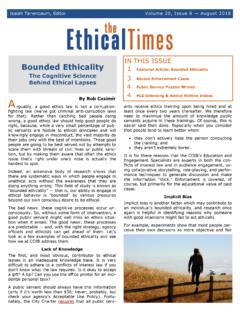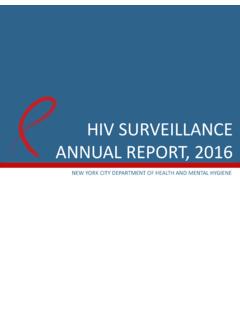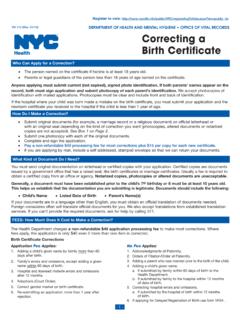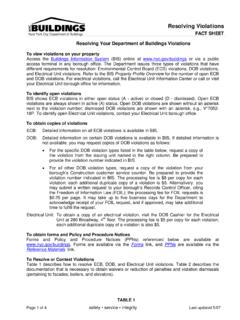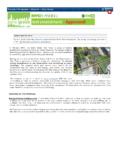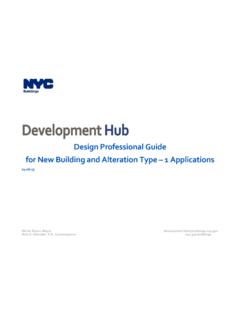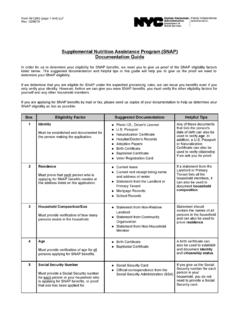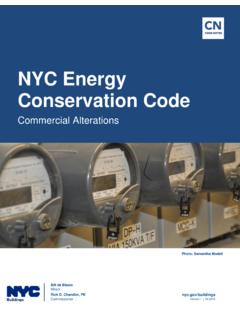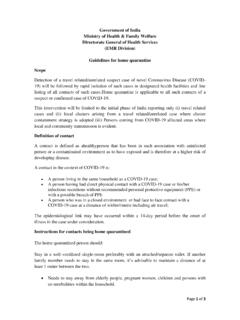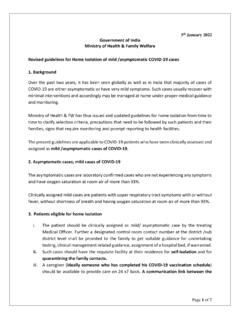Transcription of COVID-19: Understanding Quarantine and Isolation
1 1 COVID-19: Understanding Quarantine and Isolation Quarantine Isolation What does it mean? Staying home, monitoring your health and separating from others after being recently in close contact with someone who has COVID-19. Staying home, monitoring your health and separating from others when you have COVID-19 or COVID-19 symptoms. Who needs to do this? People who were in close contact with someone who has COVID-19 and either: Are not up to date on their COVID-19 vaccines Have not had COVID-19 in the last 90 days Everyone else does not need to Quarantine but should get tested, wear a face mask and follow other precautions.
2 People who test positive for COVID-19 or have COVID-19 symptoms, even if they are vaccinated. Why should I do this? If you are near someone with COVID-19, you are more likely to get it. Staying home prevents the spread to others. You can have and spread COVID-19 even if you do not have symptoms. Staying home prevents the spread to others. You can spread COVID-19 even if you do not have symptoms. Where should I stay? At home or a free Take Care hotel. Call 212-COVID19 (212-268-4319) or visit At home or a free Take Care hotel. Call 212-COVID19 (212-268-4319) or visit How long do I need to do this?
3 At least five days after your last close contact with the person who has COVID-19. Wear a mask around others and follow key prevention measures for 10 days after your last close contact. At least five days from when your symptoms began (or if you had no symptoms, your test date). If your symptoms do not improve or you have had fever in the past 24 hours, keep isolating. Wear a mask around others and follow key prevention measures for 10 days after your symptoms began (or test date, if you had no symptoms). Should I get tested for COVID-19? Yes, you should get tested five days after your last close contact with someone who has COVID-19 or right after you develop symptoms.
4 If you have symptoms, get tested right away. Stay isolated while waiting for your test result. Should I get medical care? Take your temperature twice daily and monitor for other symptoms. Contact your health care provider if you develop symptoms. Go to a hospital or call 911 if you have trouble breathing or another medical emergency. Take your temperature twice daily and monitor for other symptoms. Contact your health care provider to let them know you tested positive or have symptoms and discuss treatment options. Go to a hospital or call 911 if you have trouble breathing or another medical emergency.
5 How do I protect other household members? Avoid being near them as much as possible. Wear a mask whenever not alone in a room. Clean and disinfect your home. Avoid being near them as much as possible. Wear a mask whenever not alone in a room. Clean and disinfect your home often. Can I go to work or school? Some people can go to work or school (see below). No. Where am I allowed to go? To get essential medical care (including testing) and basic needs, like groceries, if you have no other way to get them. To get essential medical care (including testing) and basic needs, like groceries, if you have no other way to get them.
6 2 Quarantine What does it mean to be fully vaccinated and up to date? Fully vaccinated means it has been at least two weeks since your second dose of the Pfizer or Moderna vaccine or single-dose Johnson & Johnson vaccine. People who got a two-dose vaccine or combination of vaccines authorized by the World Health Organization are also fully vaccinated. Up to date means you are fully vaccinated and have received additional doses and booster shots when eligible, including: Your two-dose (Pfizer or Moderna) or one-dose (Johnson & Johnson) primary vaccine A third dose if you have a weakened immune system (if eligible) A booster shot ( if eligible) For information on third dose and booster shot eligibility, see and What is a close contact?
7 Close contacts are people who have been within 6 feet of someone who has COVID-19, for 15 minutes or more over a 24-hour period. This can be from two days before the person with COVID-19 s symptoms began (or if they have no symptoms, two days before they tested positive). Usually, everyone living with someone who has COVID-19 are close contacts. This definition may change in places like schools and health care facilities. Who does not need to Quarantine , and what precautions should they take? You do not need to Quarantine if you either: Are up to date with your vaccines Had COVID-19 in the last 90 days (as confirmed by a positive viral test) o 90 days is from when you first had COVID-19 symptoms or, if you had no symptoms, the date of your first positive test.
8 If you are a close contact who does not need to Quarantine , follow these precautions: Monitor symptoms for 10 days after your last contact with the person who has COVID-19. Get tested five days after your last close contact or right after you develop COVID-19 symptoms. If you had COVID-19 in the last 90 days, you do not need to get tested unless you develop symptoms. Isolate right away if you develop symptoms or test positive. Wear a well-fitting mask around others for 10 days after your last close contact (including at home). For 10 days after your last close contact, avoid spending time: o With people who are immunocompromised, are age 65 and older, or have a medical condition that increases their risk for severe COVID-19 o In nursing homes and other high-risk settings 3 Who needs to Quarantine , and for how long?
9 Close contacts who are not up to date with their vaccines must Quarantine for at least five days from their last close contact with the person who has COVID-19. You should get tested at least five days after your last close contact with the person who has COVID-19 or right away if you develop COVID-19 symptoms: If your test result is negative or you are unable to get tested, you can end Quarantine after Day 5. Wear a well-fitting mask for 10 days after your last close contact and follow other precautions (see below). If your test result is positive, isolate.
10 Some people must Quarantine for more than five days: Children age 2 and under and others who cannot wear a well-fitting mask must Quarantine for 10 days. Some high-risk settings, such as nursing homes, may have different Quarantine requirements. The day after your last close contact with someone who has COVID-19 is Day 1 of Quarantine . For example, if your last close contact was on January 1 and you Quarantine for five days, your last day of Quarantine is January 6 and you can end Quarantine on January 7. What prevention measures should I follow during Quarantine and after Quarantine ends?
